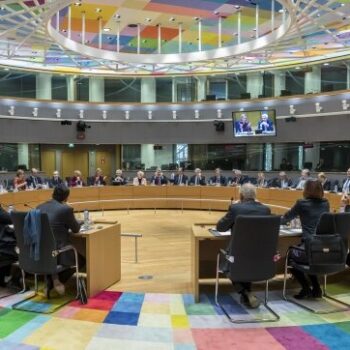Beneath the surface of the headline-grabbing political positioning at the G7 and Singapore Summit, countries are quietly cooperating to deliver low carbon resilient transition.
You will be forgiven for missing it but in the past month Europe, Canada, China, India, Brazil, Mexico, Indonesia – even the U.S. – came together in search of security and prosperity and to double-down on efforts to accelerate the transition to a low carbon economy. In May, the European Commission along with Denmark, Finland, Norway, Sweden, the Nordic Council of Ministers played host to the 9th Clean Energy Ministerial and the 3rd Mission Innovation Ministerial; and this month the first-ever Powering Past Coal working-level meeting took place in Berlin. This is what we call real economy diplomacy: countries and economic actors coming together to share ideas and provide mutual support as they rewire our economies away from fossil-fuels towards carbon neutrality.
The Clean Energy Ministerial
When the 26 member countries met at their 9th annual Ministerial their message was clear: expanding clean energy is a top priority globally. With Clean Energy Ministerial (CEM) countries accounting for approximately 90% of global clean energy investment and 75% of global greenhouse gas emissions, the CEM is an important forum for tackling climate change. At this year’s meeting in Copenhagen, The Netherlands was officially welcomed as the newest member of the forum and Poland and Argentina also attended, looking to deepen their engagement in the future. Surely a positive sign?
The beauty of the CEM’s model is that it combines technical working groups with annual ministerial meetings to maintain political buy-in. This could serve as a model to accelerate the transition in other regions such as South East Asia.
Each year the Ministers meet for ‘focused dialogue’ and sign-off on a few short-term “campaigns” designed to elevate a particular aspect of the transition and galvanize international support to do more. For example, the CEM’s 21st Century Power Partnership (21CPP) supports five major emerging economies – India, China, Mexico, South Africa and Brazil – to help integrate more renewable energy into their electricity grids. Concretely, this means technical workshops around renewable energy auctions, next-generation modeling practices, regulation of distributed generation and workforce development. Politically this translates into increased confidence in that country’s renewable energy target and, hopefully, increased ambition in their NDC.
This year the CEM launched new campaigns to accelerate the participation of women in the clean energy sector, promote wider adoption of long-term energy scenarios and use of energy modeling in countries with limited experience. Existing campaigns promote the sale of electric vehicles and corporate procurement of renewables. These and other campaigns illustrate how rapidly the world of energy is changing. Since its creation the CEM has become a key collaborative forum where countries can come together to reflect and share their struggles, and together with private sector partners, problem solve those thorny issues – nobody said this was going to be easy.
Mission Innovation
While the CEM is about faster deployment of today’s available technologies, Mission Innovation (MI) is about faster development of tomorrow’s solutions. Without innovation, we cannot meet climate targets in the 2030-2050 timeframe, so in this way MI is a critical part of implementing the Pairs Agreement. At the Third Mission Innovation Ministerial (MI-3) the international community gathered in Malmo to discuss bold steps to enhance public and private investment and collaboration on clean energy research and innovation. Halfway through the initial five-year commitment period – MI was launched by 19 Heads of State and Bill Gates during the Paris COP in 2015 – Ministers demonstrated significant progress on MI’s goals. An additional 4 billion USD of public sector funding in clean energy innovation has been invested since 2015, more if you count increases in the U.S. (despite the Administration’s best effort to cut funding Congress has protected R&D investments in clean energy for the most part). Nearly 40 new international research and innovation partnerships have been initiated. For example, Canada is investing 20 million CAD and collaborating with the United Kingdom on a smart grid and energy storage innovation. Korea is also an MI member increasing R&D dollars and international collaboration around the key innovation challenges.
While everyone is focused on the “trade wars”, countries gathered in Malmo focused on delivering the transformation we need, recognizing this can only be achieved when governments collaborate and partner with the private sector. And they are – in unprecedented ways – focused on research development and demonstration (RD&D) around storage, mass heating and cooling solutions, sustainable biofuels, CCUS, hydrogen market-based solutions and converting sunlight into a liquid fuel. MI’s Innovation Challenges are global calls to action aimed at accelerating RD&D in technology where Mission Innovation members believe increased international attention can make a significant impact on our shared fight against climate change. While some of these are early stage, these are potentially game-changing solutions. Countries are cooperating to hasten the development of new low-carbon products and services and their pathway to market and widespread adoption.
As a community we are so focused on temperature targets and trajectories that we can get despondent with the slow pace of progress or stuck in linear-based thinking and incrementalism. If any one of these technology breakthroughs is developed and brought to market it could bring about exponential change, and potentially massive emission reductions. To the sceptics, look at your iPhone; it did not exist 10 years ago and only came about as a result of such public R&D programs and partnerships such as those sponsored by Mission Innovation.
Powering Past Coal Alliance
This week in Berlin the member countries of the Powering Past Coal Alliance met for its first working-level meeting of member countries. This ongoing and growing campaign aims to accelerate the phase-out of coal globally. The 40+ members came together to share experience and knowledge as they transition from coal domestically. They also agreed to join forces diplomatically to persuade other countries, companies and regions to join them in accelerating the phase-out of unabated coal and put pressure on international finance on coal.
Key part of the multilateral system
These are just three examples from the past month where multiple parties have come together and gotten down to the business of the transition. Not sidetracked by grandstanding or being splashed across the front pages, the political dynamics across these platforms are more constructive as the countries collaborate and cooperate to rewire our economies for a low carbon future. Such straightforward and smart cooperative action on climate change is sorely needed. The CEM, MI and PPCA are all part of the necessary architecture to build a climate safe world, and in the process, help hold the international rules-based system together. Collectively we need to support and shine a light on these substantive and diplomatic endeavors.


